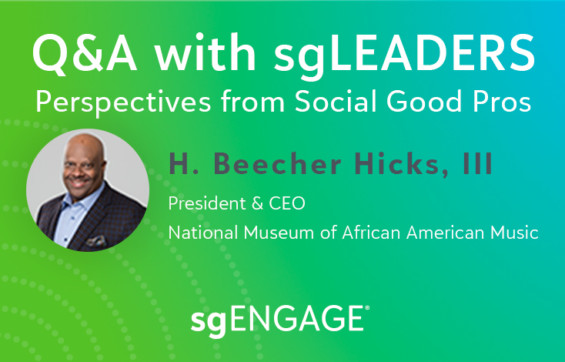Q&A with sgLEADERS: H. Beecher Hicks, III, National Museum of African American Music

The “Q&A with sgLEADERS” series on sgENGAGE aims to provide readers, including the next generation of social good leaders, with valuable insights from executives across the social good community.
Today’s Q&A is with H. Beecher Hicks III, President & CEO of the National Museum of African American Music (NMAAM) in Nashville, TN. NMAAM is the only museum dedicated to preserving and celebrating the many music genres created, influenced, and inspired by African Americans.
Even though the Museum’s official physical opening was delayed by the COVID-19 pandemic, NMAAM has been developing unique programs and other offerings to serve the community without a physical exhibit space for the past four years.
Q: Prior to becoming President & CEO of the National Museum of African American Music (NMAAM), you had a long, successful career in investment banking and finance. However, you actually began your career working in social good as a White House Fellow focused on the Corporation for National and Community Service and AmeriCorps Promise Fellows programs. What made you decide to take the helm at NMAAM and return as a social good leader in a professional capacity?
A: It was a bit accidental, but I do believe the Lord works in mysterious ways. In my family, we teach the idea that service is the price you pay for the space you occupy, so I saw this project as something that would be good for the city of Nashville and the 28% of African Americans making up the population, as well as for the music industry and the nation. It just made sense, and a leader was needed to push hard to make it happen. I was at a point in my career where I could make a detour, and it was one of the best decisions I’ve ever made. The results have been outstanding, and the work is rewarding.
Q: When construction began on NMAAM’s physical location four years ago, you simultaneously launched a “Museum Without Walls” program which included a large online component and has engaged over 50,000 people. How were you able to leverage this experience when the Museum’s physical opening was delayed due to COVID-19? What lessons did you carry forward to continue to engage existing and new attendees and supporters?
A: Donors made it clear to me we needed to be living out the mission before they would support physical construction. That made perfect sense and is, in fact, the leading pillar of our mission statement. We should be educating before we do anything else. The pandemic forced us to be more innovative, and our team stepped up to the plate. The 50,000 we’ve reached was an annual, in-person figure.
We’ve now reached several hundred thousand youth and adults through online platforms, have completed a curriculum to match our Rivers of Rhythm exhibition available through Schoology, have partnered with Quaver Music to make our From Nothing to Something youth program available nationally, and installed live-streaming equipment in our theatre to permit us to broadcast programs and events from the museum over the internet as well. Technology enables us to be as national as our name implies. Even though the museum is now open, the Museum Without Walls will continue.
Q: NMAAM is now officially open to the public- congratulations! How have the relationships you’ve built in the local community and with online supporters helped you with opening the Museum, and how do you plan to continue to leverage those relationships for future publicity and support?
A: Our online community has allowed our museum opening to be received by a larger number of friends and fans than it would have normally. Our media coverage has been broader and more global because of the Museum Without Walls and our pivot to finding ways to reach communities online. We will continue to speak to those audiences.
We will be hosting a regular series of events at the museum in person and online, starting with our Grand Opening events scheduled for June, looking for ways to partner with other institutions around the country, and to establish footholds for our programs in cities like Los Angeles, Atlanta, and New York.
Q: What accomplishment are you most proud of as President & CEO of the National Museum of African American Music?
A: I’m most proud we’ve delivered a first-rate product for Nashville and the world that it is a different spin on a museum and of the commitment our board and team showed to making it happen. It really is a monumental occasion, and I hope the nation is proud of this team’s work.
Q: What role does technology play in your organization, and how do you see it continuing to have an impact in the future?
A: Technology ties us all together. We’ve already discussed how it connects us to the community, but it also allows our teammates to work collaboratively in a virtual world, makes our customer/donor relationship data easier to use and manage, and streamlines our financial reporting. For example, our adoption of Blackbaud is just beginning. The suite of products is already making a difference, and we are ramping up adoption to take advantage of how it can make our work more seamless.
Q: What is the best piece of advice you’ve received that has guided the way you lead?
A: Listen to overcome objections, look for patterns in data, and Dream Big – but then Execute.
Q: What are you reading right now and/or what podcast are you listening to?
A: I am reading Barack Obama’s A Promised Land and Lonnie Bunch’s A Fool’s Errand. I am also listening to the We Sound Crazy podcast hosted by some friends in the music industry to learn more about the inner workings of the space I am now working in.

